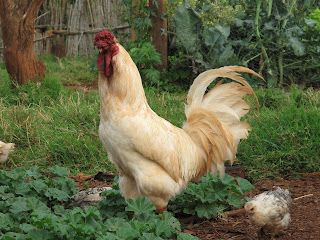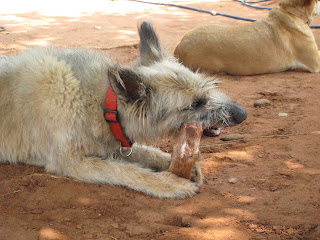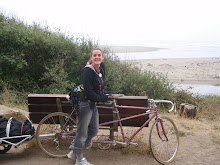But speaking of seasons, this time of year is citrus season galore.
 At any time, starting around June and still in progress, I can walk out my door, walk 15 m and pick my fill of tangerines (called mandarinas), oranges, pomelos (similar to grapefruits, but much sweeter), and limóns (which are orange in color and look exactly like the mandarinas--don't confuse the two and accidentally eat a limón like a mandarina. That's not fun.) And when Paraguayans eat citrus, they really eat some citrus. Not just one or two tangerines or oranges at a sitting, but more like 5 or 6 or 7 or more. They'll go out, pick an entire bucket full of their choice of citrus, and then the whole family sits around and eats them all. ALL. They think I'm so weird when I only want to eat one per afternoon. Well, that's at least one of the many, many, many reasons why they think I'm weird.
At any time, starting around June and still in progress, I can walk out my door, walk 15 m and pick my fill of tangerines (called mandarinas), oranges, pomelos (similar to grapefruits, but much sweeter), and limóns (which are orange in color and look exactly like the mandarinas--don't confuse the two and accidentally eat a limón like a mandarina. That's not fun.) And when Paraguayans eat citrus, they really eat some citrus. Not just one or two tangerines or oranges at a sitting, but more like 5 or 6 or 7 or more. They'll go out, pick an entire bucket full of their choice of citrus, and then the whole family sits around and eats them all. ALL. They think I'm so weird when I only want to eat one per afternoon. Well, that's at least one of the many, many, many reasons why they think I'm weird. In addition to having these citrus trees around the house, some families also have citrus orchards that they harvest when they're producing well. This year, my family's young pomelo orchard did much better than last year and we harvested it at the end of June. I was psyched to help out because 1)it didn't happen last year, 2)doing stuff in the field always makes me feel productive, and 3)I love doing the hard stuff with other females. At 7:00 in the morning, my host dad Cristino, host sister Cari, two neighbor girls Blanca and Mariela and I set out to pick and bag the pomelos. Cristino doesn't have any sons to help out with the physical labor required to maintain a 10 hectare farm, so Cari and I are his go-to girls. Getting the neighbor girls to help was a bonus this day and just added to my strong, female power feeling. I was initially told that that was all the work was going to entail because then a truck was going to drive into the field, pick up the bags and take them
In addition to having these citrus trees around the house, some families also have citrus orchards that they harvest when they're producing well. This year, my family's young pomelo orchard did much better than last year and we harvested it at the end of June. I was psyched to help out because 1)it didn't happen last year, 2)doing stuff in the field always makes me feel productive, and 3)I love doing the hard stuff with other females. At 7:00 in the morning, my host dad Cristino, host sister Cari, two neighbor girls Blanca and Mariela and I set out to pick and bag the pomelos. Cristino doesn't have any sons to help out with the physical labor required to maintain a 10 hectare farm, so Cari and I are his go-to girls. Getting the neighbor girls to help was a bonus this day and just added to my strong, female power feeling. I was initially told that that was all the work was going to entail because then a truck was going to drive into the field, pick up the bags and take them  to the road where a bigger truck would then come by at noon to take them to the purchaser. But lo and behold, the field was way too muddy for a truck to drive into so instead we were going to have to manually carry the bags up to the road. With about two hours to complete this new task, the 5 of us began the slow process of carrying the 40 45-50 lb bags the 500 m uphill to the road. One (per person) at a time. I didn't think this was going to be so bad, but the combination of awkward cargo, muddy trails, slippery stream crossings and a time crunch totally wore me out! It was a good worn out
to the road where a bigger truck would then come by at noon to take them to the purchaser. But lo and behold, the field was way too muddy for a truck to drive into so instead we were going to have to manually carry the bags up to the road. With about two hours to complete this new task, the 5 of us began the slow process of carrying the 40 45-50 lb bags the 500 m uphill to the road. One (per person) at a time. I didn't think this was going to be so bad, but the combination of awkward cargo, muddy trails, slippery stream crossings and a time crunch totally wore me out! It was a good worn out  though and I was really proud of all of us for getting all the bags up to road just in time to eat a few pomelos, take some pictures, and weigh the bags before the truck arrived. I was completely exhausted and took a hard core siesta after lunch. Poor Mariela and Blanca had to spend the afternoon in their 8th grade classroom! There's no way I could've stayed awake for that. Cristino was happy about the ~600 kilos of pomelos he gets to "sell" this year (it's complicated, the trees were initially given out for free from this company with the agreement that the grower when then pay them back through the harvests over the next however many years. i'm not sure of all the details, and i'm never quite sure if this is a good system, but it happens all the time here). I was appalled to learn that they were being sold at around 600 Guaranis per kilo. That's about $0.15/lb. Good thing I'm free labor.
though and I was really proud of all of us for getting all the bags up to road just in time to eat a few pomelos, take some pictures, and weigh the bags before the truck arrived. I was completely exhausted and took a hard core siesta after lunch. Poor Mariela and Blanca had to spend the afternoon in their 8th grade classroom! There's no way I could've stayed awake for that. Cristino was happy about the ~600 kilos of pomelos he gets to "sell" this year (it's complicated, the trees were initially given out for free from this company with the agreement that the grower when then pay them back through the harvests over the next however many years. i'm not sure of all the details, and i'm never quite sure if this is a good system, but it happens all the time here). I was appalled to learn that they were being sold at around 600 Guaranis per kilo. That's about $0.15/lb. Good thing I'm free labor. and I took advantage of the kids' free time and free school space to have a mini art camp. As things generally don't go as planned when you're a PC voluteer in Paraguay, my art camp plans of course did not work out. It poured rain the night before and morning of the first scheduled day, so that didn't happen. The next day was still really cloudy and wet (translation: no one leaves their house), so that didn't happen either. The third day, however, we were up and running. I purposely didn't tell many people about my plans because I didn't want to deal with 5000 kids. No, let me rephrase that. I cannot deal with more than about 20 at a time, and that's pushing it. But I told my favorite families, and I told a few more on my way to the school that morning, and it was perfect. About 15 kids showed up and we made bird/animal masks. I brought the photocopies of the outlines from the PC office (it's a very common environmental education project here) so they spent the morning coloring, cutting, gluing and then wearing their new masks. They really loved it and I had a wonderful time hanging out with [most of] them! Especially the younger ones, whom I enjoy more and more everyday. And a big thanks to everyone out there who was sent/brought markers and crayons!!! I could not have done this project without them!
and I took advantage of the kids' free time and free school space to have a mini art camp. As things generally don't go as planned when you're a PC voluteer in Paraguay, my art camp plans of course did not work out. It poured rain the night before and morning of the first scheduled day, so that didn't happen. The next day was still really cloudy and wet (translation: no one leaves their house), so that didn't happen either. The third day, however, we were up and running. I purposely didn't tell many people about my plans because I didn't want to deal with 5000 kids. No, let me rephrase that. I cannot deal with more than about 20 at a time, and that's pushing it. But I told my favorite families, and I told a few more on my way to the school that morning, and it was perfect. About 15 kids showed up and we made bird/animal masks. I brought the photocopies of the outlines from the PC office (it's a very common environmental education project here) so they spent the morning coloring, cutting, gluing and then wearing their new masks. They really loved it and I had a wonderful time hanging out with [most of] them! Especially the younger ones, whom I enjoy more and more everyday. And a big thanks to everyone out there who was sent/brought markers and crayons!!! I could not have done this project without them! all the rain-out days), the kids wanted to do some more fun art projects with me so we met again for Day 2. Word spread fast the day before about how awesome me and my art projects are, so as Day 2 class got under way, there were close to 25 kids! Way too many for my liking, but what can you do? I can't blame them for wanting to hang out with me! But I can constantly tell them to "Wait!", "Be patient!", "You have to share!", "Stop yelling!" and "That's not your problem." All in Guarani. I'm fluent when it comes to disciplining children. I don't mean to make is sound like it wasn't fun, because it was. Just a little more stressful than the day before. First, we made wallets out of old milk cartons. This is an awesome and very easy recycled art project that another volunteer taught me. And thanks to the super cool colored duct tape my parents recently sent to me, their wallets are a classy blue and purple (adorned with lucha libre stickers I brought) instead of weird
all the rain-out days), the kids wanted to do some more fun art projects with me so we met again for Day 2. Word spread fast the day before about how awesome me and my art projects are, so as Day 2 class got under way, there were close to 25 kids! Way too many for my liking, but what can you do? I can't blame them for wanting to hang out with me! But I can constantly tell them to "Wait!", "Be patient!", "You have to share!", "Stop yelling!" and "That's not your problem." All in Guarani. I'm fluent when it comes to disciplining children. I don't mean to make is sound like it wasn't fun, because it was. Just a little more stressful than the day before. First, we made wallets out of old milk cartons. This is an awesome and very easy recycled art project that another volunteer taught me. And thanks to the super cool colored duct tape my parents recently sent to me, their wallets are a classy blue and purple (adorned with lucha libre stickers I brought) instead of weird old milk box label colors. After the wallets came the long-awaited making of play-doh! Ever since Liv brought me a pack of play-doh when she came to visit (and I mentioned we could make our own), they've been dying to make their own. Probably so they don't have to come to my house to play with it because that means following my "no mixing" rule. I don't like my colors mixed. That's just the way it has to be. Anyway, both the making of and playing with the play-doh went wonderfully. Even though their colors aren't as cool as mine (we used food coloring and it didn't turn out very bright), they could mix away if they wanted! And normally Paraguayan children have a very difficult time being creative (creativity is severely stifled and NEVER encouraged in their school system), but they were doing great that morning! No one asked me what they should make, ideas were flowing freely and it kept them entertained for a good 30 minutes. That may not seem like much, but trust me, it is.
old milk box label colors. After the wallets came the long-awaited making of play-doh! Ever since Liv brought me a pack of play-doh when she came to visit (and I mentioned we could make our own), they've been dying to make their own. Probably so they don't have to come to my house to play with it because that means following my "no mixing" rule. I don't like my colors mixed. That's just the way it has to be. Anyway, both the making of and playing with the play-doh went wonderfully. Even though their colors aren't as cool as mine (we used food coloring and it didn't turn out very bright), they could mix away if they wanted! And normally Paraguayan children have a very difficult time being creative (creativity is severely stifled and NEVER encouraged in their school system), but they were doing great that morning! No one asked me what they should make, ideas were flowing freely and it kept them entertained for a good 30 minutes. That may not seem like much, but trust me, it is.

















































